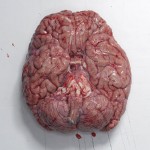 A University of Toronto study shows that visual attention — the brain’s ability to selectively filter unattended or unwanted information from reaching awareness — diminishes with age, leaving older adults less capable of filtering out distracting or irrelevant information.
A University of Toronto study shows that visual attention — the brain’s ability to selectively filter unattended or unwanted information from reaching awareness — diminishes with age, leaving older adults less capable of filtering out distracting or irrelevant information.
Further, this age-related “leaky” attentional filter fundamentally impacts the way visual information is encoded into memory. Older adults with impaired visual attention have better memory for “irrelevant” information. The research, conducted by members of U of T’s Department of Psychology, will be published Wednesday, November 3 in the Journal of Neuroscience.
In the study, the research team examined brain images using functional magnetic resonance imaging (fMRI) on a group of young (mean age = 22 years) and older adults (mean age = 77 years) while they looked at pictures of overlapping faces and places (houses and buildings). Participants were asked to only pay attention to the faces and to identify the gender of the person. Even though they could see the place in the image, it was not relevant to the task at hand
“In young adults, the brain region for processing faces was active while the brain region for processing places was not,” said Taylor Schmitz, lead author of the research paper. “However, both the face and place regions were active in older people. This means that even at early stages of perception, older adults were less capable of filtering out the distracting information. Moreover, on a surprise memory test 10 minutes after the scan, older adults were more likely to recognize what face was originally paired with what house.”
The findings suggest that under attentionally-demanding conditions, such as looking for one’s keys on a cluttered table, age-related problems with “tuning in” to the desired object may be linked to the way in which information is selected and processed in the sensory areas of the brain. Both the relevant sensory information — the keys — and the irrelevant information — the clutter — are perceived and encoded more or less equally. In older adults, these changes in visual attention may broadly influence many of the cognitive deficits typically observed in normal aging, particularly memory.
The study was conducted by Eve De Rosa, Taylor Schmitz and Frederick H.T. Cheng, all of U of T’s Department of Psychology. Data was collected in the Department of Psychology and at the Rotman Research Institute at Baycrest Hospital. The research was supported by the Canadian Institutes of Health Research and the Natural Sciences and Engineering Research Council of Canada.
Image Source: Brain AtlasSource: University of Toronto
